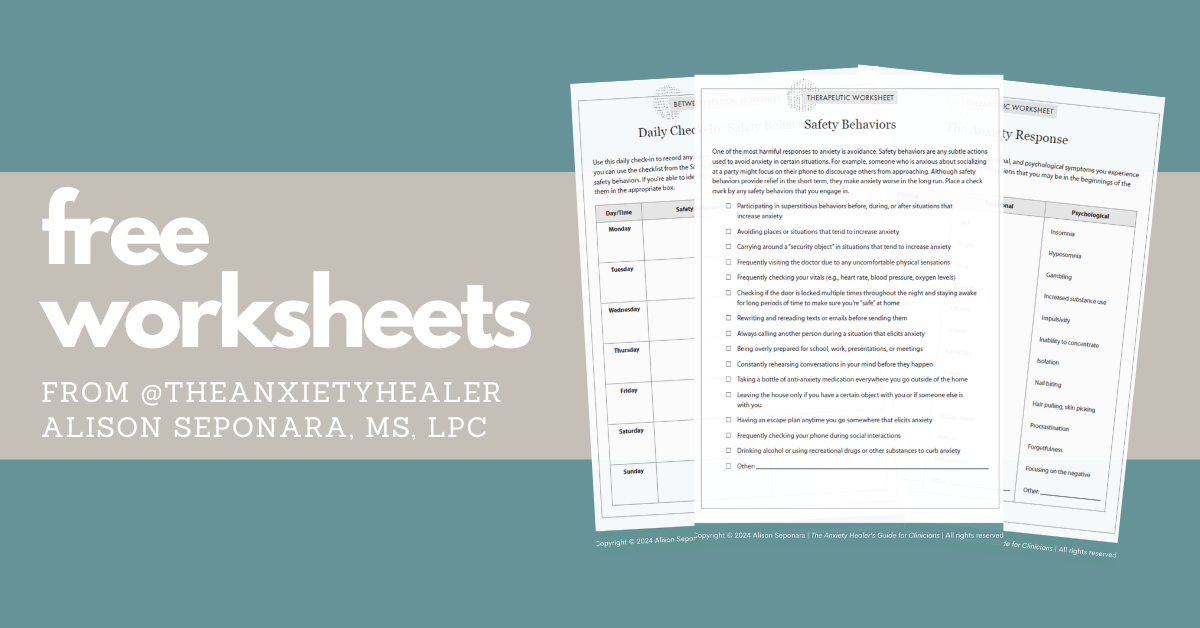Understanding and Overcoming the Four Stages of Anxiety

Anxiety often feels relentless, like a never-ending cycle. This cycle, familiar to many, unfolds in four different stages. It’s a process that many people experience, often without even realizing it. The progression from one stage to the next can feel almost automatic, as if it were following a well-worn path. It all starts with a triggering event or situation that causes intense fear or worry (Stage 1). This overwhelming fear leads to avoidance (Stage 2) as a way to escape distress. While this avoidance brings short-term relief (Stage 3), it’s only temporary. The anxiety soon returns, often more intense than before (Stage 4), leaving an individual feeling even more out of control in the long run. Understanding this toxic cycle can help calm anxiety, opening minds to lasting relief.
As a result, the person may experience symptoms such as:
Avoidance can also involve safety behaviors, which are subtle techniques used to prevent or cope with anxiety-provoking situations. These might include carrying a comfort object like anti-anxiety medication or a cell phone, constantly googling feared symptoms, seeking reassurance from others, or always having an escape plan. To break this cycle, individuals must gradually confront their fears in a slow and systematic manner.
Although negative reinforcement can reduce anxiety momentarily, it leads to avoidance becoming the primary coping mechanism. This relief is increasingly short-lived as untreated symptoms worsen. Ultimately, this avoidance magnifies symptoms, leaving individuals feeling powerless against their anxiety.
Breaking free from this cycle requires guiding individuals to safely confront and face their fears. Although challenging, this approach is essential for successful treatment and long-term relief from anxiety.
Understanding the anxious cycle is crucial for helping clients breaking free from its grip. By recognizing the stages of anxiety, your clients can begin to see how their behaviors contribute to their ongoing distress. Remember that the key to overcoming this cycle lies in gradually confronting and facing fears in a safe and systematic way. With the right strategies and support, it’s possible for your clients to disrupt this pattern and regain control over anxiety, allowing them to have more control over their lives.
Keep essential information about the anxiety cycle at your fingertips with this printable worksheet by anxiety expert Alison Seponara. This handy resource offers a quick and easy reference to the four distinct stages of anxiety, from the initial trigger that sparks intense fear to the heightened long-term anxiety.
Stage 1: Anxiety Ensues
The anxiety cycle begins when an individual is triggered by a stressful event or situation, causing them to enter fight-or-flight mode. This triggering event can vary widely, from an intrusive thought or image to a memory, physical sensation, social situation, relationship interaction, or even a social media post.As a result, the person may experience symptoms such as:
- Feeling nervous, restless, or on edge
- Sensing impending danger or doom
- Having an increased heart rate
- Rapid breathing
- Sweating
- Trembling
- Feeling weak and tired
- Having trouble sleeping
- Excessive worry
Stage 2: Avoidance
When anxiety symptoms become unbearable, individuals often resort to avoidance to escape the triggering event. This avoidance can manifest in various ways, such as skipping class to dodge a presentation, using drugs or alcohol to numb feelings, procrastinating on challenging tasks, avoiding confrontations, canceling plans, ignoring calls and texts, leaving social situations early, or even just falling asleep to escape the discomfort.Avoidance can also involve safety behaviors, which are subtle techniques used to prevent or cope with anxiety-provoking situations. These might include carrying a comfort object like anti-anxiety medication or a cell phone, constantly googling feared symptoms, seeking reassurance from others, or always having an escape plan. To break this cycle, individuals must gradually confront their fears in a slow and systematic manner.
Stage 3: Short-Term Relief
Avoidance behaviors might offer short-term relief, but they are not beneficial in the long run. The more someone avoids a situation, the more they reinforce this behavior, even if it feels better temporarily. According to The OCD and Anxiety Center, negative reinforcements can be as powerful as positive ones. Any behavior that is rewarded, whether negatively or positively, is more likely to continue. While people are generally familiar with positive reinforcements like rewards, negative reinforcement involves removing an aversive stimulus, which provides relief. In this context, the aversive stimulus is the issue causing the anxiety.Although negative reinforcement can reduce anxiety momentarily, it leads to avoidance becoming the primary coping mechanism. This relief is increasingly short-lived as untreated symptoms worsen. Ultimately, this avoidance magnifies symptoms, leaving individuals feeling powerless against their anxiety.
Stage 4: Heightened Long-Term Anxiety
The anxiety cycle culminates in persistent, heightened anxiety over a longer period of time. When individuals rely on avoidant behaviors to manage anxiety, their ability to tolerate distress declines. The initial fear that prompted the avoidance intensifies, and the brain learns that avoidance is the only way to alleviate anxious symptoms. Consequently, the anxiety worsens with each occurrence, making avoidance significantly more likely. This repetitive cycle traps individuals in a state of heightened anxiety.Breaking free from this cycle requires guiding individuals to safely confront and face their fears. Although challenging, this approach is essential for successful treatment and long-term relief from anxiety.
Understanding the anxious cycle is crucial for helping clients breaking free from its grip. By recognizing the stages of anxiety, your clients can begin to see how their behaviors contribute to their ongoing distress. Remember that the key to overcoming this cycle lies in gradually confronting and facing fears in a safe and systematic way. With the right strategies and support, it’s possible for your clients to disrupt this pattern and regain control over anxiety, allowing them to have more control over their lives.
Keep essential information about the anxiety cycle at your fingertips with this printable worksheet by anxiety expert Alison Seponara. This handy resource offers a quick and easy reference to the four distinct stages of anxiety, from the initial trigger that sparks intense fear to the heightened long-term anxiety.
The Anxiety Healer’s Guide for Clinicians: Over 85 Cognitive Behavioral Strategies to Help Anxious Clients Calm the Mind and Body

Help clients tackle their anxiety head-on by working with them to create a tailored anxiety toolkit. In The Anxiety Healer’s Guide for Clinicians, you’ll find customizable, holistic interventions that empower clients to actively engage in their own healing process long after they’ve left your office.
Created by one of Instagram’s most followed therapists, @theanxietyhealer Alison Seponara, this comprehensive resource is filled with practical, concrete strategies you can use to help anxious clients create a unique toolkit that works specifically for their needs.
Created by one of Instagram’s most followed therapists, @theanxietyhealer Alison Seponara, this comprehensive resource is filled with practical, concrete strategies you can use to help anxious clients create a unique toolkit that works specifically for their needs.
FREE LIVE EVENT
Calming the Anxious Mind & Body: Create New Neural Pathways for Regulation with Integrative CBT
Calming the Anxious Mind & Body: Create New Neural Pathways for Regulation with Integrative CBT

Helping your clients tackle their anxiety requires a custom toolkit tailored for what works for them. You should never run out of new and creative treatment interventions.
Join Alison Seponara, MS, LPC for this FREE 3-hour training as she teaches you how to help clients regulate the anxious mind & body by creating new neural pathways with integrative CBT. Focusing on actionable neuroscience-based strategies, Alison specializes in tailoring integrative treatment for anxious clients who are high-functioning yet struggle to find lasting relief from their symptoms.
Join Alison Seponara, MS, LPC for this FREE 3-hour training as she teaches you how to help clients regulate the anxious mind & body by creating new neural pathways with integrative CBT. Focusing on actionable neuroscience-based strategies, Alison specializes in tailoring integrative treatment for anxious clients who are high-functioning yet struggle to find lasting relief from their symptoms.






